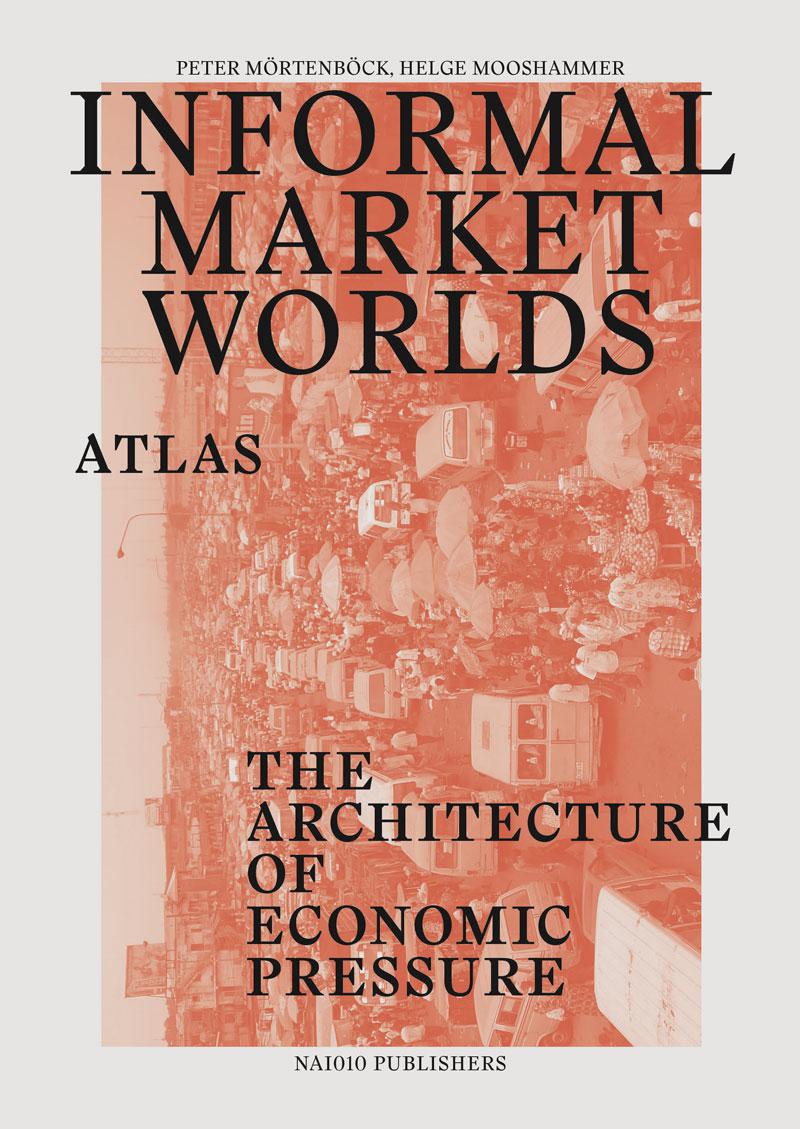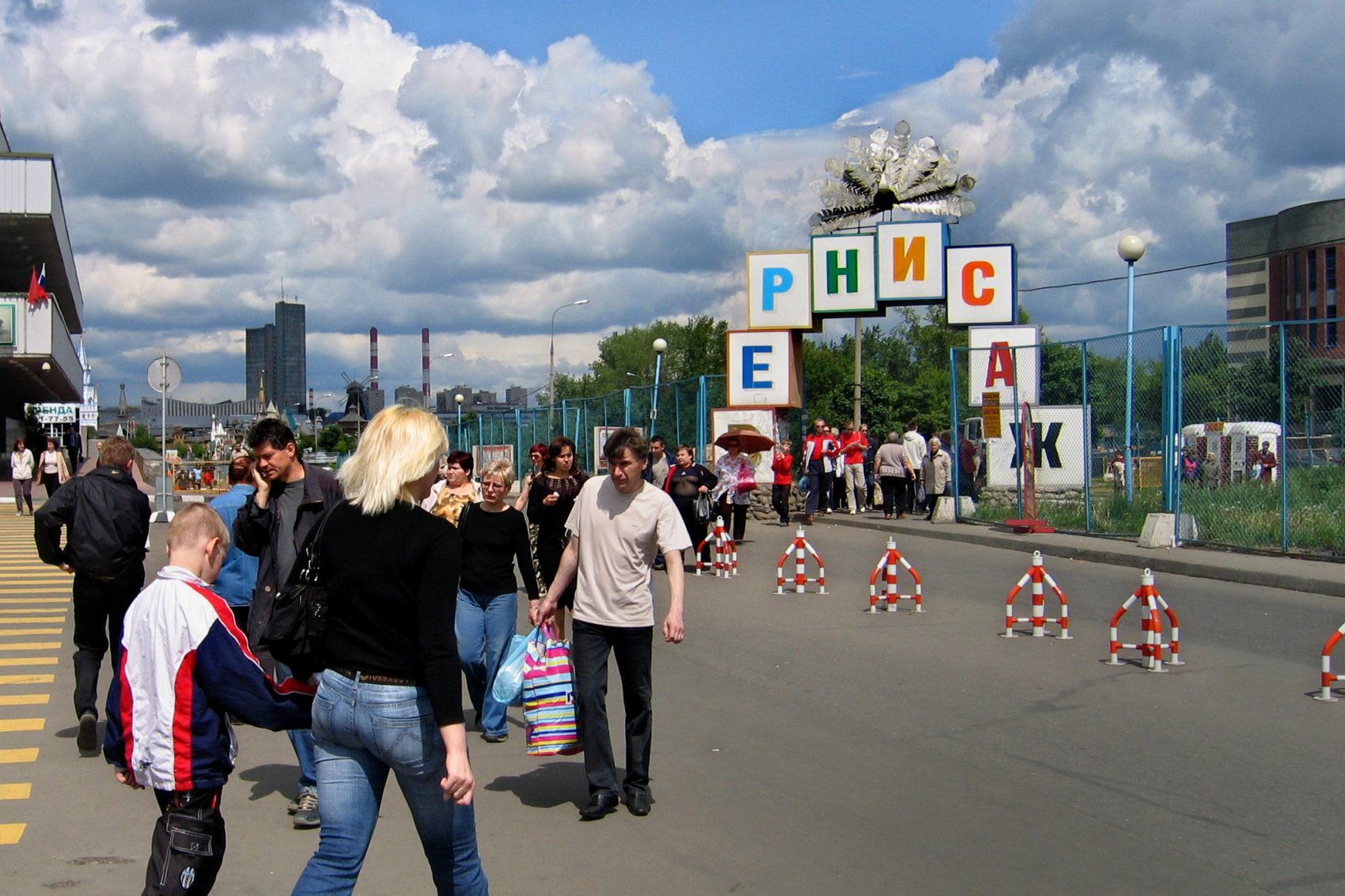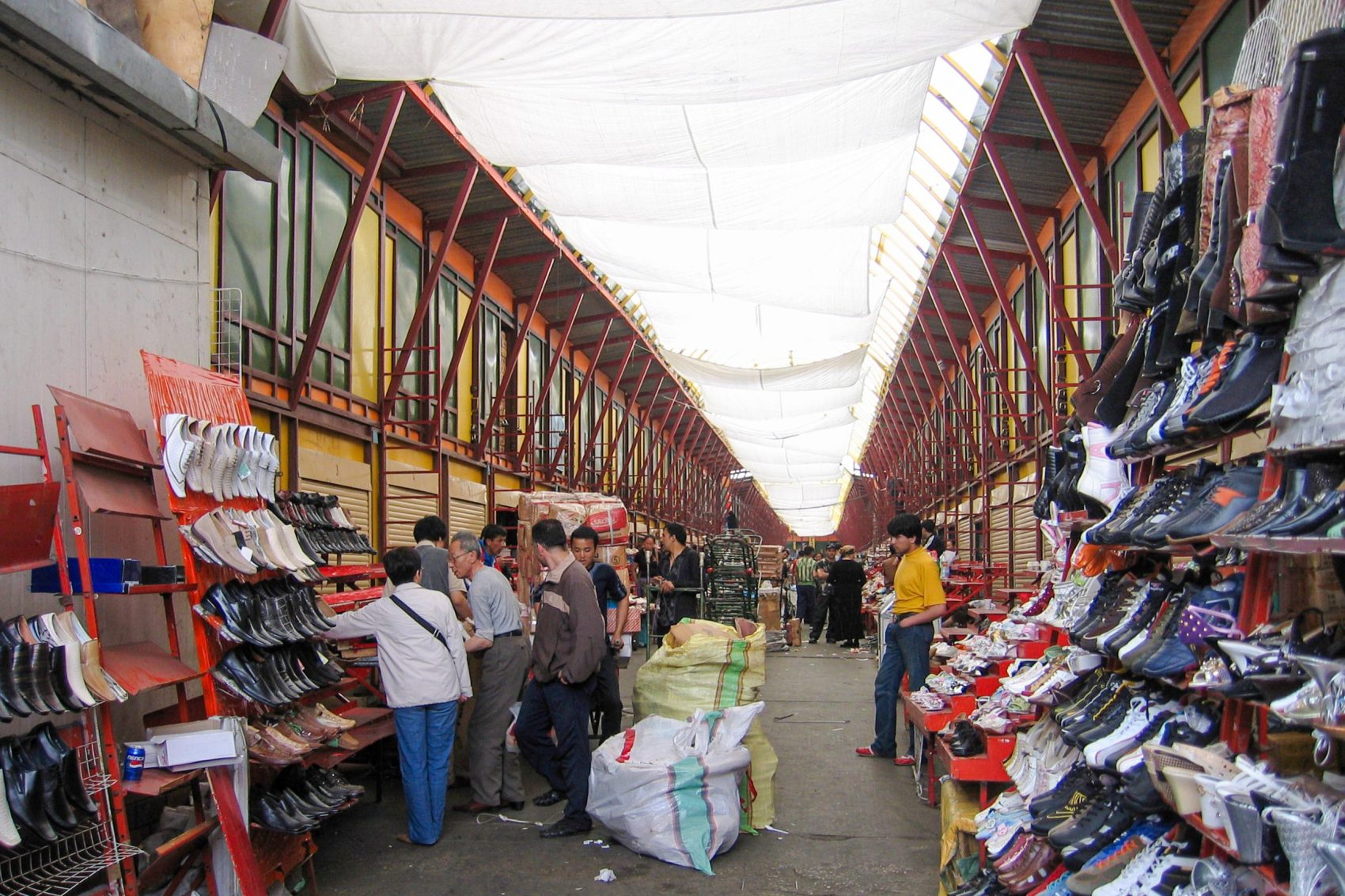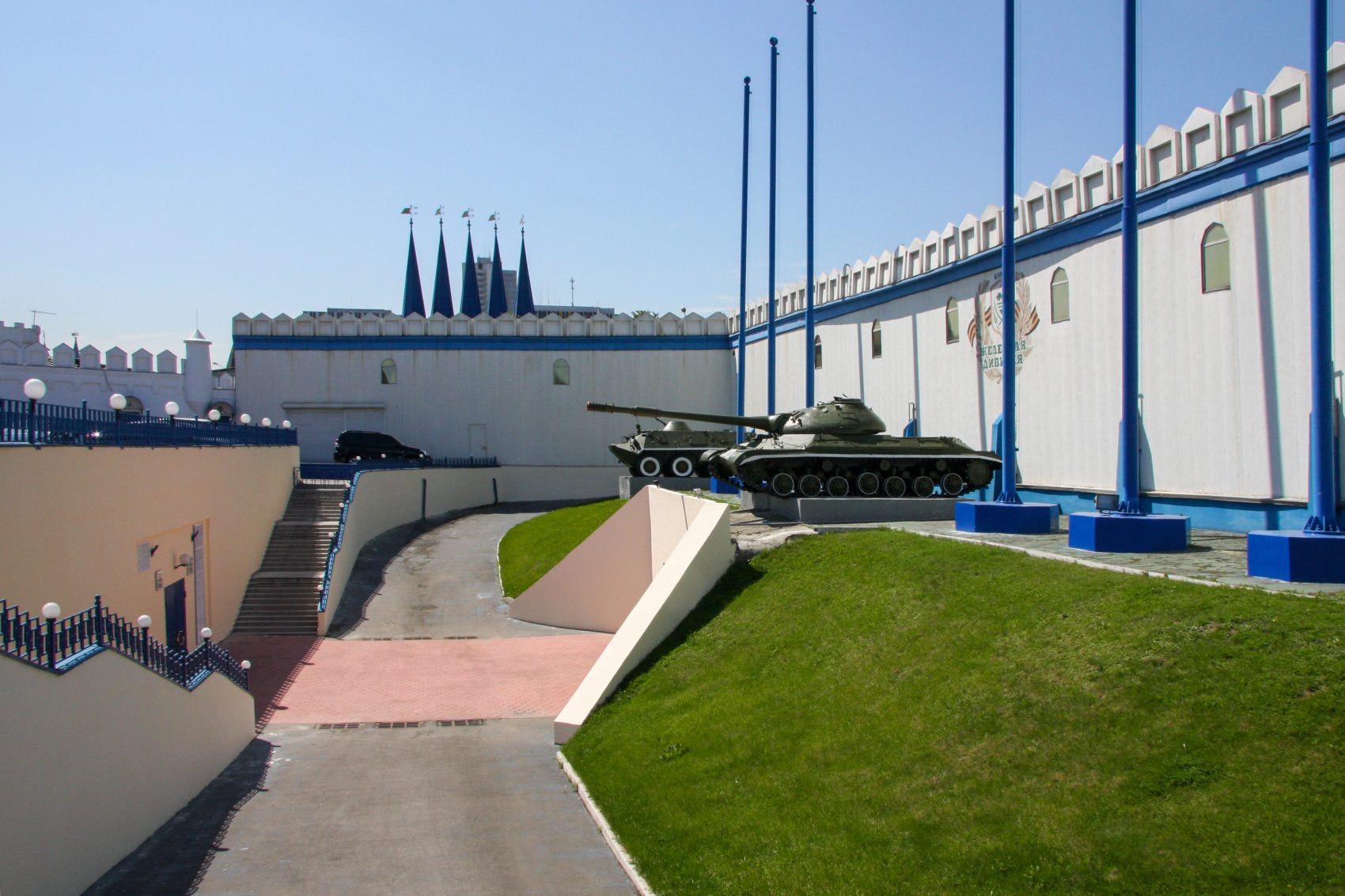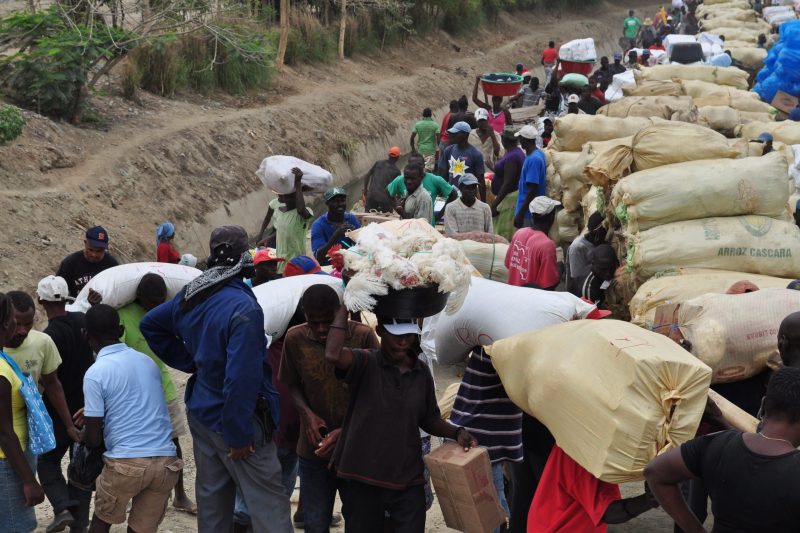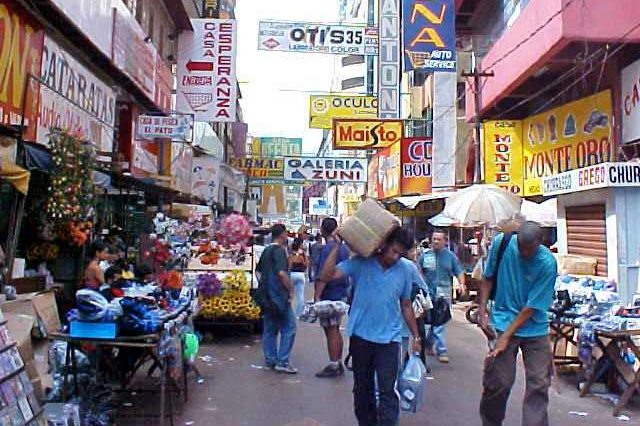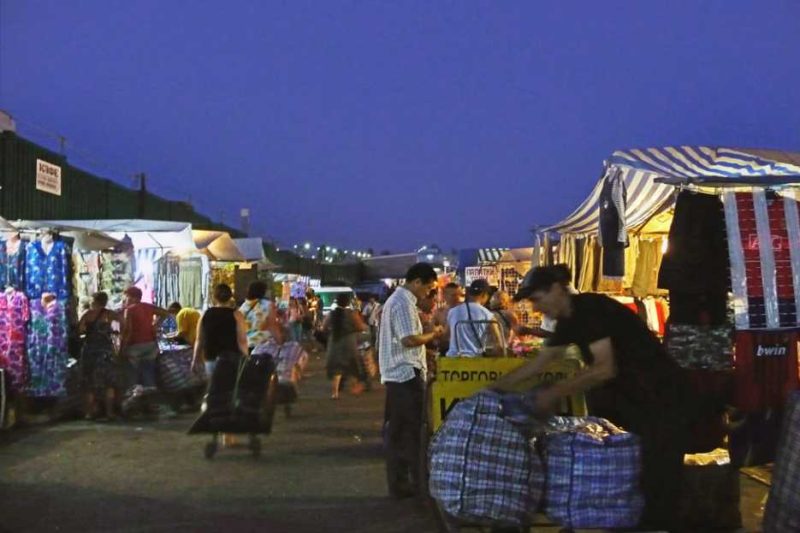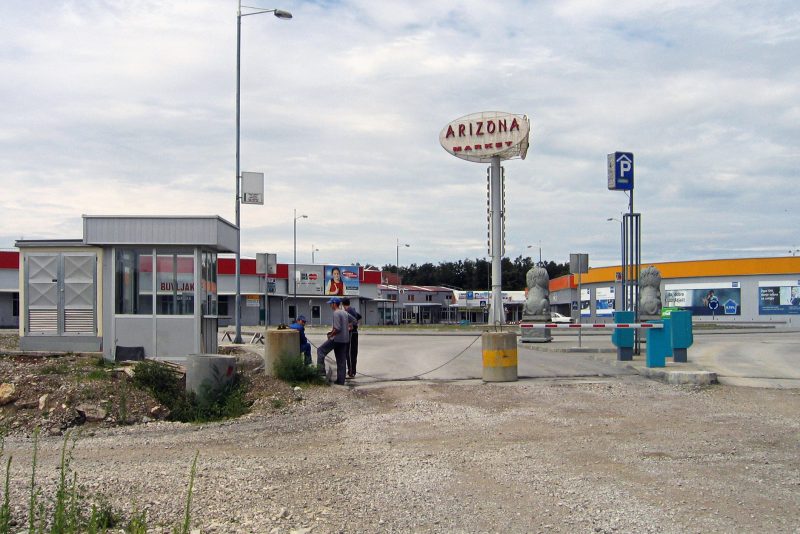- TRANS-NATIONALITY: LEGAL ARCHITECTURES
- FWF
- 2010-2015
- Other Markets
CASE STUDY: CHERKIZOVSKY MARKET
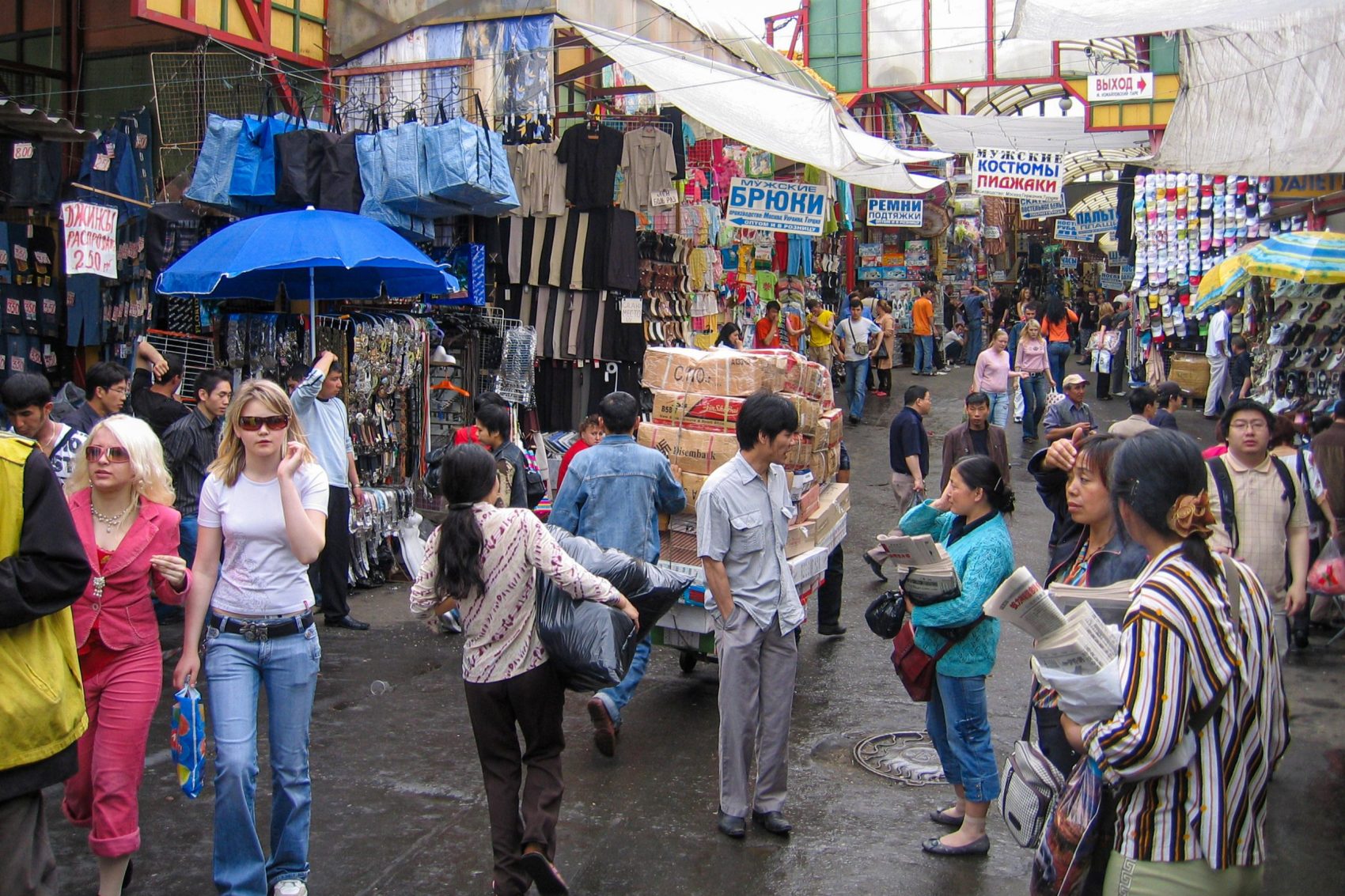
Central area of Cherkizovsky Market, 2006
MOSCOW IZMAILOVO: VISITING STALIN
In the north east of Moscow, on an area three times the size of that occupied by the Kremlin, fifteen specialised trading areas form a rampantly growing bazaar structure that completely surrounds Izmailovo Stadium and includes all sorts of attractions: from Eurasian wholesale markets to a reconstruction of Tsar Alexander’s wooden palace in the Vernisazh complex, specially erected for tourists and the sale of arts and crafts.
The market’s ‘owners’ are among Russia’s new millionaires, while at the lower end of the new market-economy scale, there are thousands of migrants from Tajikistan, Uzbekistan, China and an extended Southeast Asia, who have come to seek work at the market as stall-minders, carriers and tea-sellers seven days a week. They sleep in the metal storage containers (above the stalls or on the periphery of the market) or in the cellars of the stadium. In this state of modern slavery, they are not only at the mercy of exploitative employers, but also of arbitrary police behaviour and gangs of young thugs. As a result, many of them never dare to go more than a few hundred meters from the market.
In September 2006, one month after a bombing which killed thirteen people and left fifty-three badly wounded, the vice-speaker of Moscow City Council announced that the market would be closing at the end of 2006. A few weeks later, the head of the Department of the Consumer Market of Moscow announced that most of the trading places on the site of the Russian State University of Physical Education (RGUFK) would be taken down by 1 July 2007, and the remainder by the end of 2007. This, it was said, would allow the site to be returned to its proper use, as a space where people could devote themselves to physical culture. But how is it possible to determine the ‘proper’ use of a space, especially in an age of global restructuring? Does its use as a venue for sports events really do justice to the original plans? Or isn’t it simply a by-product, a parasitical use of its potential?
During the XXII Olympic Summer Games in 1980, the RGUFK site served as one of the locations of the Moscow Games. For the weight-lifting events, a new indoor arena, the Izmailovo Sports Palace, was erected. At the southern end of the site, next to Izmailovo Park underground station, the Olympic village was constructed in the form of a four-tower hotel complex with 8,000 beds. The stadium itself, which stands in the middle of the grounds, was built during the 1930s. It is a fragment of the envisaged ‘Central Stadium of the Soviet Union’ planned by Stalin to accommodate 120,000 spectators. Never completed, it also served to camouflage the ‘Reserve Command Centre of the Supreme Commander-in-Chief of the Red Army, I.V. Stalin’.
Location(s):Moscow, RUSSIA
On-Site Collaborator:PETER MÖRTENBÖCK
HELGE MOOSHAMMER
Photography: PETER MÖRTENBÖCK
HELGE MOOSHAMMER
Results of this case study were published in:
Ultimately, the construction of the stadium was inspired by more than purely sporting considerations. Not only was the stadium intended to be bigger than Berlin’s Olympic Stadium, and its peculiar asymmetrical form designed to hold grandiose military parades at which the columns of tanks could roll into the stadium unhindered from the parade ground to the east. It was also conceived as part of a vast military infrastructure covering the entire Soviet Union. Situated seventeen kilometres to the east of the Kremlin, a bunker beneath the stadium was designed as an intermediary stop-over point in case Hitler should launch a surprise attack on Moscow and the Soviet Command have to be evacuated to Samara, 1,000 kilometres away in the Urals. Consequently, sports events in Izmailovo have always been part of a far greater system of deceptions and compensatory gestures. Cultural events are just as important as strategically embedded building structures for preserving this system. Events such as these helped to sustain policies that were imitated with ever greater rapidity when the RGUFK site was converted into one of the largest informal trading centres in the Russian Federation.
Cherkizovsky Market was a product of the politics of individual initiatives promoted by Perestroika. Under its banner, members of the state sports institute began to use the grounds and buildings commercially. In June 1989, Sergei Korniyenko and a ‘collective of enthusiasts’ leased the stadium buildings. Under the terms of the contract, the spectators stands and the sports fields are to be available for events such as Spartakiade 2000 (‘For a United and Healthy Russia in the 21st Century’). The remaining spaces, like those beneath the stands, can be used commercially. FOP, the Sports Health Enterprise founded in 1989, proved to be extremely innovative. Nowadays, in conjunction with the New Historical Cultural Centre Izmailovo (NIC Izmailovo, founded in 1995), it operates enterprises as diverse as an arbalest shooting range, the Aero Fitness Club, various bars, the Lux Sauna, the Alain Beauty Salon (up to ‘European standard’) and the Preobrazheniye (Transformation) School for the Spiritual Development of Man, which is run by a cosmic artist-healer.
Furthermore, FOP played a vital role in the ‘rediscovery’ of Stalin’s old bunker. In 1994, the Iron Division club helped to organise a museum exhibition which was taken over from the Central Museum of the Armed Forces and opened as a branch on 1 September 1999. Adjacent to the bunker rooms, FOP operates a Georgian-style restaurant called Visiting Stalin, as well as a concert hall (holding 200 people) used for performances by the Prince Sergei Korniyenko Orchestra. Even though the bunker was apparently never used by Stalin himself – just as the stadium never performed the function originally anticipated – one can now book a bunker tour for a little over 100 US dollars. The price includes a visit to the reconstructed conference hall of the Supreme Command of the Red Army, as well as to Stalin’s study and recreational and leisure areas, plus a dinner at ‘Stalin’.
Whereas the stadium was originally supposed to provide an arena for mass performances demonstrating the superiority of the political order of the Soviet Union, it has now become the archaeological site testifying to the inner emptiness of a Babylonian city-within-a-city into the cracks of which the ants of globalisation have now moved. No longer do revolutionary tanks roll or patriotic armies march on the parade ground, which has disappeared beneath the Eurasia Market. Instead, thousands of carriers and tea-sellers swarm out around the endless labyrinth of its kilometres-long halls to keep this rough trading organism alive.
As a central trading place for the sheer necessities of life, the Cherkizovsky Market has become the contested scene of cultural identities where attempts to reconstruct a Russian national identity encounter the complex realities of a globalised migration-economy. The progressive commercialisation of even the tiniest of niches has generated a large number of unforeseen spaces for micro-cultural negotiations, like the one for the 3,000 Mountain Jews from the Caucasus, for whom a 20-square-metre room – laid out with carpets and located between the shoe storerooms and the sportsmen’s and women’s toilets in the caverns of the stadium stands – serves as a synagogue. Like the majority of the hundreds of thousands of people whose existences are inextricably tied up with the market, they, too, are both marginalised and transformed into targets of a global tug-o-war over cultural identity. To some, they are ‘blacks’, to some they are not orthodox enough, while some doubt whether they are Jews at all.
While the owners’ good contacts to the government and the mayor have led to repeated delays in implementing the plans to close the markets, a ruling to restrict the share of foreign workers at markets to 40 per cent, which came into effect on 1 April 2007, really did have a widespread impact. From Moscow to Vladivostock, there are reports of markets collapsing completely. This has not only affected immigrants working at the market, but also all those impoverished sections of the Russian population who are dependent on the cheap products available at these markets. These policies (Russia for the Russians), which are propagated by Russia’s prime minister and former president Vladimir Putin, are frequently seen as a tactically motivated response to the increase in racially inspired attacks. Consequently, the bombers of 12 August 2006, who felt that there were ‘too many Asians at the market’, ultimately did not only kill thirteen people and wound fifty-three others, but also affected, with their actions, the existence(s) of an estimated five million illegal immigrants in Russia.
On 29 June 2009 the market was finally shut down by Russia’s consumer watchdog Rospotrebnadzor due to 464 alleged violations of fire safety regulations and after earlier raids had unearthed 6,000 containers of counterfeit goods. Though having been anticipated for some time (1), this lockdown took many of the 100,000 migrant workers, who suddenly found themselves locked out with no access to their trading stock, by surprise. Stallholders and suitcase traders protested for days outside the locked market gates. A group of Vietnamese market workers trying to block a nearby highway were arrested and given deportation orders (2).
Immediate crisis talks between Chinese officials and the Russian government about the implications of the closure for the 60,000 strong Chinese community involved in the market lead to arrangements for traders to withdraw their stock from the market at regulated times. In a step forward, Russia and China expressed their mutual interest in establishing a standardised, transparent and convenient trade environment. In order to achieve sustained and sound development of bilateral trade, both parties agreed that it would be essential to tackle the problem of ‘grey customs clearance’ as it had been practiced at Cherkizovsky market (3). Work to bring the market stuctures down began in September 2009 and the RGUFK is keen to get its territory back. On 20 October 2009 Moscow Mayor Yuri Luzhkov signed a decree on a revised listing of Moscow’s markets that no longer includes Cherkizovsky Market. On that day, Cherkizovsky Market officially ceased to exist.
(1) A number of international media have reported that growing alienation between former close allies Moscow Mayor Yuri Luzhkov and the oligarch Telman Ismailov which built up during June 2009 may have contributed to the market’s sudden closure. See “Oligarch pays for party that enraged Putin,” The Independent, 16 July 2009, http://www.independent.co.uk/news/world/europe/oligarch-pays-for-party-that-enraged-putin-1748289.html or “Vladimir Putin ‘furious’ over flaunting oligarch Telman Ismailov,” Sunday Times, 28 June 2009, http://www.timesonline.co.uk/tol/news/world/europe/article6591398.ece
(2) “Notorious Moscow market unlikely to reopen – watchdog,” RIA novosti, 14 July 2009, http://en.rian.ru/russia/20090714/155523059.html
(3) “Cherkizovsky Market closure heralds transformation of trade,” China Daily, 6 August 2009, http://www.chinadaily.com.cn/world/2009-08/06/content_8533540.html
CONTRIBUTOR(S)
PETER MÖRTENBÖCK is Professor of VISUAL CULTURE at the TU Wien, Co-Director of the CENTRE FOR GLOBAL ARCHITECTURE and Senior Research Fellow at Goldsmiths College, University of London.His current research is focused on the architecture of the political community and the economisation of the city, as well as the global use of raw materials, urban infrastructures and new data publics.Together with HELGE MOOSHAMMER, he curated the Austrian Pavilion at the Venice Architecture Biennale 2021, which explored the theme of “platform urbanism”.PETER MÖRTENBÖCK’s appointment at the TU Wien was preceded by two other offers of a professorship in Vienna – Professor of Architectural Design (Geography, Landscapes, Cities) at the Academy of Fine Arts Vienna(2018) and Professor of Architectural Theory at the University of Applied Arts Vienna (2019). Following his professorial habilitation in the field of cultural history at the TU Graz he was immediately offered the position of Professor of Media Aesthetics at the University of Paderborn, a position he held in 2002. Prior to this he was a guest professor of fine art at the University of Art and Design Linzfrom 2000 to 2001, and from 1998 to 2000 he conducted research at Goldsmiths College, University of London, and returned there as a Marie Curie Intra-European Fellow from 2005 to 2007.
HELGE MOOSHAMMER is an architect, author and curator. He conducts urban and cultural research in the Department of VISUAL CULTURE at the TU Wien, is Co-Director of the CENTRE FOR GLOBAL ARCHITECTURE, and Research Fellow at Goldsmiths College, University of London.He has initiated and directed numerous international research projects focusing on issues relating to (post)capitalist urban economics and urban informality, including the Austrian Science Fund (FWF) projects “Relational Architecture” (2006-09), “Other Markets” (2010-15) and “Incorporating Informality” (2018-23). In 2008 he was a Research Fellow at the Internationales Forschungszentrum für Kulturwissenschaften (IFK) in Vienna. He has taught at a number of institutions, including the University of Art and Design Linz, the Merz Akademie Stuttgart, and Goldsmiths College, University of London. HELGE MOOSHAMMER’s current research is focused on architecture, contemporary art and new forms of urban sociality in a context shaped by processes of trans-nationalisation, neo-liberalisation and infrastructuring. Together with PETER MÖRTENBÖCK he curated the Austrian Pavilion at the Venice Architecture Biennale 2021, which explored the theme of “platform urbanism”.
